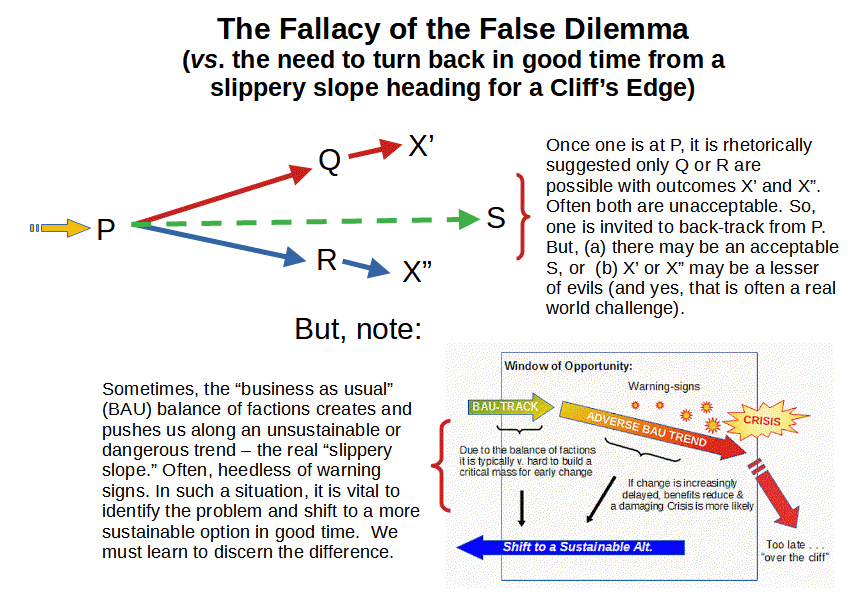A classic rhetorical tactic is to pose a dilemma, an argument where the opponent is presented with alternatives, all bad so forcing him or her to either make a bad choice or back away from the position taken. In a variant, one of the choices is presented as a lesser of evils, which is to be taken even reluctantly.
It is a powerful rhetorical strategy, and so it is often posed even when it is unwarranted, which is where fallacious dilemma arguments come from. This post is about that fallacious case, and the following infographic will help:

Here, we see how policy proposal or argued position P is presented with a dilemma, Q XOR R — two exclusive, allegedly exhaustive options, but where each leads to an unpalatable or unacceptable outcome, X’ or X”. The so trapped party is then invited to retreat (or in some cases to pick the lesser evil, say X’).
This form of argument is closely related to the very respectable argument form, reduction to absurdity, where one fork being absurd, one takes the other as truth given P.
HT, ZW, two classic cases from the gospels may help to clarify how powerful and even dangerous a dilemma can be. A woman is thrown down before Jesus as he teaches in the Temple: adulteress caught in the act. Moses said stone such, what do you say? Similarly, is it lawful to pay taxes to Caesar? Each of these was a yes/no — and yes such are often used by wicked interrogators insisting on short answers they can readily twist — Stone her, you are a rebel against Rome, do not stone her you are a heretic against Moses (and we will lynch you). Do not pay and Rome will crucify you as a rebel, pay and you are a traitor to Israel. Both times, Jesus took the third option.
So, how does one deal with a dilemma?
- It might be that indeed, one must retreat from P (though, most of the time that is not likely)
- Sometimes, the forced alternative is not valid and a third way, S, can be taken that leads to a good result or a less worse one than P or Q. A classic case is the Euthyphro argument on roots of morality and the theistic answer that God is the root of reality who is inherently good and utterly wise, where also the good and right are sufficiently intelligible that we are not forced to act blindly
- In a high form of the art of rhetoric, some pose a counter-dilemma that gives an even worse choice to the other party, substituting Q’ and R’ for Q and R, to force the other party to retreat.
In any case, a dilemma is not easy to deal with at all.
There is another related case that comes up on policy matters. The business as usual trend in a community reflects the balance of its power factions and sometimes is on a road to disaster. The run up to the two World Wars is a classic pair of cases. The issue then becomes finding a credible alternative and building a critical mass coalition to switch to it before it is too late.
If that fails, preach the good word but spend your 120 years building an ark. END